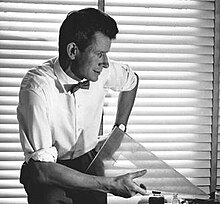Robin Day (designer)
| Robin Day OBE FCSD |
|
|---|---|

Robin Day
|
|
| Born |
25 May 1915 High Wycombe, England |
| Died | 9 November 2010 (aged 95) England |
| Nationality | British |
| Education | Royal College of Art |
| Alma mater | High Wycombe School of Art |
| Occupation | Furniture designer and Industrial designer |
| Known for | Polypropylene chair, Hille furniture, Royal Festival Hall seating |
| Spouse(s) | Lucienne Day |
| Children | Paula |
| Website | Robin and Lucienne Day Foundation |
Robin Day, OBE, FCSD (25 May 1915 – 9 November 2010) was one of the most significant British furniture designers of the 20th century, enjoying a long career spanning seven decades. An accomplished industrial and interior designer, he was also active in the fields of graphics and exhibitions.
His wife Lucienne Day, née Conradi (1917–2010) was a renowned textile designer. The couple married in 1942 and had one daughter, Paula Day (born 1954).
Robin Day grew up in the furniture-making town of High Wycombe in Buckinghamshire. High Wycombe Technical Institute, where he was a junior day student, had close links with the local furniture industry. Being gifted at drawing, Day progressed to High Wycombe School of Art in 1931 and then won a scholarship to study design at the Royal College of Art in 1934. On leaving the RCA in 1938, there were no suitable openings in the furniture industry, so he made architectural models and took a teaching post at Beckenham School of Art, where he developed a ground-breaking course in 3D design.
Day met his future wife, Désirée Conradi, in 1940 at a dance at the RCA, where she was studying printed textile design. They married in 1942, moving into a flat in Chelsea. In 1952 the couple moved to a house on Cheyne Walk, their home and joint studio for the next 50 years.
After the Second World War, Robin Day taught interior design at the Regent Street Polytechnic (now the University of Westminster), where he met the architect Peter Moro (1911-1998). The two men formed a partnership in 1946 designing public information exhibitions, mainly for the Central Office of Information and other government organisations, on subjects such as jet engines and scientific instruments. Day continued designing exhibitions and trade stands until the early 1960s for clients such as the radio manufacturer EKCO and the industrial giant ICI. A talented graphic designer, he also designed an eye-catching series of recruitment posters for the RAF during 1948-9.
Although the war had impeded Day’s ambition to become a furniture designer, his fortunes changed in 1948 when he and Clive Latimer won First Prize in the Storage Section of the International Competition for Low-Cost Furniture Design organised by the Museum of Modern Art in New York. Their ingenious concept for a range of multi-purpose storage units fabricated from a tube of pre-formed moulded plywood received international acclaim. Although never mass-produced, a set of prototypes made by Heal & Son in 1949 demonstrated the principles behind the design. Supported on tubular aluminium legs, the cabinets were compact and flexible, with sliding doors, interchangeable shelf and drawer fittings and a writing desk with a drop-down flap.
...
Wikipedia
